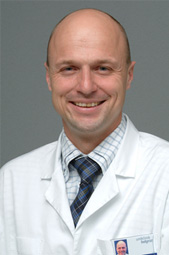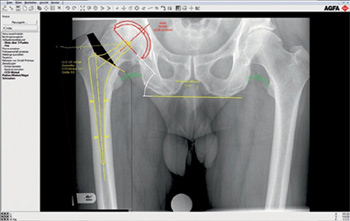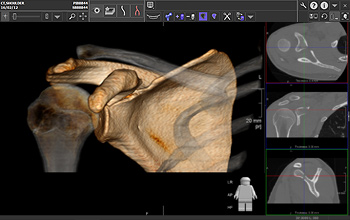



Published, 30.08.2022

In 2011, Balgrist University Hospital in Zürich switched to a centrally-operated PACS with individual tenants for multiple institutions, commonly known as a “multi-site PACS”. Since that time, it has also been using the mediCAD orthopedic planning system. The ability to work together with a contemporary system for digital operation planning and documentation was a major factor in selecting the PACS. Ensuring access to existing data was also a central issue when deciding to switch to the new system.
Multi-site PACS bidding process
With these things in mind, hospitals GZO AG Wetzikon, Limmattal, See-Spital, and Balgrist University Hospital explored their options for launching a centrally operated PACS for all four institutions. In 2009, they contracted Logicare to generate a GATT/WTO-compliant request for bids for a centrally operated system. Following the bidding process and a detailed analysis of technical and financial aspects, Logicare and the hospitals jointly selected AGFA to be the system vendor.
Centralized infrastructure
Technical implementation began in the third quarter of 2010. At the Balgrist University Hospital, a total of 10 TB of data from 500,000 examinations had to be imported into the new system. This large transfer of data required approximately three months, due in part to the need to reassign orphaned records.
Digital operation planning
In addition to implementation of the new PACS, the “mediCAD” planning software from German manufacturer hectec was introduced throughout the hospital. mediCAD is a CAD software application that is used to overlay implants and associated components in the PACS on top of radiology images. This makes it easy for a surgeon to efficiently plan a suitable socket and shaft combination, for example.

mediCAD’s implant database is a major reason for the solution’s success, since it allows a doctor to quickly choose the best implant directly on the screen. The database is continuously updated and currently contains products from 90 manufacturers around the world, covering more than 80% of all implants used in Europe. The solution fits seamlessly into the EDP systems used at the hospitals. Both the integration into the new PACS as well as the ability to access all templates have proven to be valuable features during day-to-day usage of the system at the University Hospital.
Dr. Christian W. A. Pfirrmann is a professor, head physician, and director at Balgrist University Hospital. He had this to say: „mediCAD makes many tasks easier. It is installed on every office PC and is accessible during consultation meetings and in the operating halls, making it readily accessible for everyone who needs it. It is also essential for documentation purposes and enables a post-op comparison of the planning with the actual operation.“
Before installation of the new solution, operations were planned in the conventional manner with x-ray films. But now the hospital can forgo printing of the films, thereby avoiding potential sources of errors. This saves both time and money, but improved safety is even more important. Since mediCAD is a widely used system, many people at the hospital already have experience with it. Just two short training programs of approximately two hours were adequate in order to use the system efficiently.

Prof. Dr. Christian W. A. Pfirrmann,
EMBA, is the head physician of radiology at Balgrist University Hospital in Zürich and a member of the hospital’s management board.
The most recent version 2.50 of the planning program for orthopedic surgeons and hospitals has been significantly expanded and given fresh aesthetics. Automated procedures and revised operation save additional time. In total, the new version contains more than 100 new functions and changes.
It is compatible with all planning methodologies, so processes are documented in a legally secure way. At the University Hospital, all specialized teams now use the planning solution for shoulder and hip operations and for all of the lower extremities such as knees and ankles. In addition to planning functions, mediCAD also has numerous measurement capabilities, making it an important tool during diagnostics of the spinal column, for example.
Networking hospitals
By switching to the new system, Balgrist University Hospital now has a direct connection to the Schulthess Clinic, for example. The medical connectors in DICOM format provide for secure and encrypted exchange of information with other institutions.

Authorized recipients of data can easily import radiology data into their own PACS. In addition to DICOM, other formats like PDF, .doc, XML, HL7, and CDA are also supported.
New functionality in the RIS/PACS environments, such as orthopedic planning with HECTEC or 3-D depiction, require new software and hardware elements, which often leads to a complete replacement of older PACS. However, existing data can still be used. The system replacement at the Balgrist University Hospital shows that it is possible to switch to a new system in only six months, with no interruptions